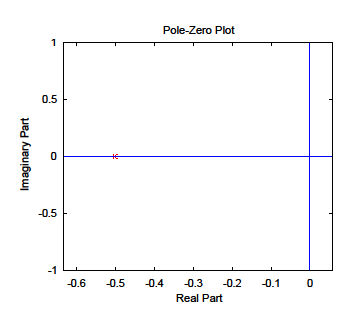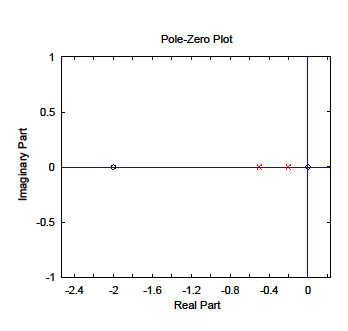
DADiSP Online Help
Click here to see this page in full context

DADiSP Worksheet Functions > Function Categories > Fourier Transforms and Signal Processing > SPLANE
Displays a Pole-Zero plot of a S
SPLANE(b, a)
|
b |
- |
A series. The numerator (i.e. zero) coefficients in descending powers of s. |
|
a |
- |
A series. The denominator (i.e. pole) coefficients in descending powers of s. |
SPLANE(z, p, g)
|
z |
- |
A series. The zeros of the S |
|
p |
- |
A series. The poles of the S |
|
g |
- |
A scalar. The gain of the system. |
SPLANE(c)
|
c |
- |
A series. The system coefficients in cascaded biquad form. If c contains 2 columns, the coefficients are assumed to be in direct form, where the first column is b and the second column is a. |
An XY series, where each pole is plotted as a light red "x" and each zero is plotted as a black "o".

W1: splane({1}, {1, 0.5})

Displays the s plane with a single pole at s = -0.5. The input is given as a system function in descending terms of s.
W1: splane({0}, {-0.5}, 1)
Displays the same plot as above. The input is given in terms of zeros and poles.

z = roots({1, 2, 0});
p = roots({1, 0.7, 0.1});
splane(z, p, 1);

Displays two real poles and two zeros in the current Window. This result is identical to:
splane({1, 2, 0}, {1, 0.7, 0.1})
For splane(b, a), the input series represent the terms of the rational polynomial

|
s |
= |
jω complex frequency |
|
N |
= |
number of numerator terms |
|
M |
= |
number of denominator terms |
For splane(z, p, g), the gain term must be present, but it does not effect the resulting plot.
For splane(c), the input c is assumed to be a single column of coefficients in cascaded

or equivalently:

where G is the system gain, bk and ak are the filter coefficients for the kth stage.
If c contains 2 columns, the coefficients are assumed to be in direct form, where the first column is b and the second column is a.
The aspect ratio of the window is set to square to preserve a circular unit circle.
Each pole is plotted as a light red "x" and each zero as a black "o". The unit circle is displayed as a solid circle in the current series color. Axes lines are also drawn through the origin.
Multiple zeros and poles are labeled with a multiplicity number to the upper right of the symbol.
See ZPLANE for a Pole-Zero plot of a discrete system.